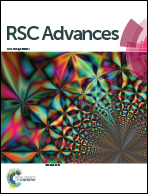Facile fabrication of silk protein sericin-mediated hierarchical hydroxyapatite-based bio-hybrid architectures: excellent adsorption of toxic heavy metals and hazardous dye from wastewater†
Abstract
Environmental pollutants, especially water pollutants, are a serious problem in modern industrial societies; therefore, there is a significant need for new approaches to water purification through the development of eco-friendly functional materials with cost-effective fabrication methods. Here, we report the inexpensive fabrication of hierarchical bio-hybrid architectures through a green and facile co-precipitation method by employing an industrial waste natural silk protein, sericin, and hydroxyapatite (HAP), the main component of bones and teeth. These hierarchical bio-hybrids show excellent adsorption of toxic heavy metal ions of Pb(II), Cd(II) and Hg(II), with adsorption efficiencies in the order of Hg(II) ≪ Cd(II) < Pb(II), and a hazardous dye, Congo red (CR), due to their large surface area and the chemical natures of sericin and HAP. The microscale size and structural integrity of the hybrids enables easy separation of the adsorbents from waste water. More than 99% adsorption of Pb(II) ions is observed within 15 min. Moreover, the simply stacked layers of hybrid flowers function as excellent filters for free-flowing polluted water, with a removal efficiency of 99.5%. This system can be used as a practical natural water treatment. Further, these hybrid adsorbents can be reused following recovery with dilute acetic acid treatment; the process also regenerates the adsorbed Pb(II) ions. The simple, economical and environmentally benign fabrication method of these hybrids and their excellent water-purifying ability will lead to a new solution to the worldwide issue of water pollution.


 Please wait while we load your content...
Please wait while we load your content...